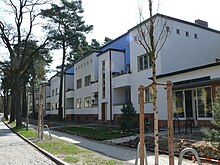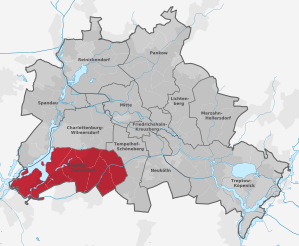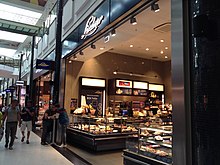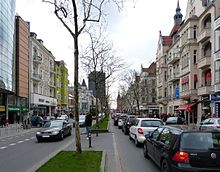Steglitz-Zehlendorf district
|
Steglitz-Zehlendorf 6th district of Berlin |
||||||||||||||||||||
|---|---|---|---|---|---|---|---|---|---|---|---|---|---|---|---|---|---|---|---|---|
| Coordinates | 52 ° 26 ′ 0 ″ N , 13 ° 15 ′ 0 ″ E | |||||||||||||||||||
| surface | 102.50 km² | |||||||||||||||||||
| Residents | 310,071 (Dec. 31, 2019) | |||||||||||||||||||
| Population density | 3025 inhabitants / km² | |||||||||||||||||||
| Proportion of foreigners | 13.5% (December 31, 2016) | |||||||||||||||||||
| Unemployment rate | 5.4% (Nov. 30, 2019) | |||||||||||||||||||
| Post Code | 12157, 12161, 12163, 12165, 12167, 12169, 12203, 12205, 12207, 12209, 12247, 12249, 14109, 14129, 14163, 14165, 14167, 14169, 14193, 14195 | |||||||||||||||||||
Administration address |
Kirchstrasse 1/3 14163 Berlin |
|||||||||||||||||||
| Website | www.steglitz-zehlendorf.de | |||||||||||||||||||
| Average age | 46.2 years (Dec 31, 2016) | |||||||||||||||||||
| structure | ||||||||||||||||||||
| District key | 06 | |||||||||||||||||||
| Structure of the district | ||||||||||||||||||||
| politics | ||||||||||||||||||||
| District Mayor | Cerstin Richter-Kotowski ( CDU ) | |||||||||||||||||||
| Deputy District Mayor | Michael Karnetzki ( SPD ) | |||||||||||||||||||
| Allocation of seats ( district assembly ) | ||||||||||||||||||||
|
||||||||||||||||||||
Steglitz-Zehlendorf is the sixth administrative district of Berlin and had 310,071 inhabitants as of December 31, 2019.
The district in the southwest of Berlin was created in 2001 as part of the Berlin administrative reform by merging the former districts of Steglitz and Zehlendorf .
Steglitz-Zehlendorf is considered a relatively wealthy residential area with a favorable social structure . Most of Berlin's income millionaires live in the area.
The university and research landscape in the district is internationally renowned and is a magnet for scientists from all over the world. The main cultural centers include a. the Berlin Literary Colloquium , the Botanical Garden , the Brücke Museum and the Titania Palace .
geography
location
Steglitz-Zehlendorf borders the Brandenburg state capital Potsdam in the west , as well as the Berlin districts of Spandau (northwest), Charlottenburg-Wilmersdorf (north) and Tempelhof-Schöneberg in the east. Kleinmachnow and Teltow in the Potsdam-Mittelmark district lie behind the state border in the south . The district extends over 19 kilometers in an east-west direction and 9 kilometers in a north-south direction.
The westernmost point of Berlin is in the district of Wannsee in the Havel , on which the border with Brandenburg runs.
colonization
The Steglitz-Zehlendorf district includes extensive recreational areas, villa settlements and various residential and commercial locations. In the west there are recreational areas such as the Wannsee , the southern Grunewald with its Krumme Lanke and Schlachtensee lakes , which are particularly popular with Berliners in summer. The district of Dahlem is the seat of numerous scientific institutions and the Free University . The Zehlendorf area has different residential areas, with a small retail area in the center. The Lichterfelde, located south of Dahlem, is characterized in the northern part by the Gründerzeit villa colony of Lichterfelde and smaller retail centers; in Lichterfelde-Süd there are partly residential areas from the time after the Second World War .
The Steglitz district further to the east, on the other hand, has a more urban structure, as shown by Schloßstraße in the center with the highest density of shops in Berlin. It represents the main center for the south-western districts of the city. Botanical Garden and Botanical Museum Berlin-Dahlem are, contrary to their own name, in the district of Lichterfelde.
The district is populated very differently. Half of the population lives in Steglitz and Lichterfelde, both of which are in the top quarter of all 96 Berlin districts in terms of population. Wannsee, the largest district of Steglitz-Zehlendorf with almost a quarter of the total area, is very sparsely populated with its three percent population.
Districts




| Districts and locations |
Area (km²) |
Residents December 30, 2019 |
Inhabitants per square kilometer |
location |
|---|---|---|---|---|
| 0601 Steglitz | 6.79 | 75,803 | 11,164 | |
0602 Lichterfelde
|
18.22 | 86.206 | 4,731 | |
| 0603 Lankwitz | 6.99 | 43,566 | 6.233 | |
| 0604 Zehlendorf | 18.83 | 60,538 | 3.215 | |
| 0605 Dahlem | 8.39 | 16,929 | 2,018 | |
| 0606 Nikolassee | 19.61 | 16,695 | 851 | |
| 0607 Wannsee | 23.68 | 10,334 | 436 |
history
The former districts of Steglitz and Zehlendorf were formed in 1920 during the formation of Greater Berlin from previously independent rural communities and manor districts of the Teltow district.
The entire area of today's district belonged to the Second World War from 1945 to 1990 along with the districts of Tempelhof , Schöneberg , Neukölln and Kreuzberg the American Sector of Berlin , see. also → divided city (there light blue area).
In 2001, the two formerly independent districts were merged to form the Steglitz-Zehlendorf district as part of the Berlin administrative reform .
population

As of December 31, 2019, the Steglitz-Zehlendorf district had 310,071 inhabitants. Due to the proportion of water and forest areas in the total area of almost 103 square kilometers as well as the mostly loosened development, the average population density on the reference date was 3,025 inhabitants per square kilometer. See also: List of districts and districts of Berlin .
In the Berlin district comparison, Steglitz-Zehlendorf is characterized by a relatively high household income of the residents and the lowest city-wide unemployment rate of 5.4% (as of November 2019). The average age of the population was 46.2 years (as of December 31, 2016), the highest of all Berlin districts, making Steglitz-Zehlendorf the district with the oldest inhabitants on average (for comparison: the Friedrichshain-Kreuzberg district has 37.8 years the youngest population).
Population groups
The proportion of foreigners on December 31, 2016 was 13.5%, while the proportion of residents with a migration background was 25.4%. However, the proportion varies between the individual districts: In the urban district of Steglitz , almost 30% of the residents have a migration background, in contrast to around 17% in the sparsely populated Wannsee . At seven of the 33 public primary schools in the district, the proportion of children with a migration background is over 40%. The largest groups of migrants from Steglitz-Zehlendorf come from Poland , Turkey , the United States , Arab countries and Russia .

| Population by origin (2012) | |
|---|---|
| Germans without a migration background | 76.6% (229,318) |
| Germans with a migration background | 11.9% (35,694) |
| Foreigners | 11.5% (34,445) |
| Migration background from EU countries (including Poland, Italy, United Kingdom) | 8.1% (24,282) |
| Migration background from Islamic countries (including Turkey , Arab League , Iran ) | 4.8% (14,423) |
| Migration background from the former Soviet Union (Russia, Ukraine, Kazakhstan) | 2.2% (6,637) |
| Migration background from former Yugoslavia (Serbia, Croatia, Bosnia) | 1.6% (4,803) |
| American immigrant background | 1.4% (4,278) |
Social
The district of Steglitz-Zehlendorf is one of the areas with the lowest birth rate in Berlin and Germany. Statistically, only 8.4 children were born for every 1000 inhabitants in 2017. The aging of the population, which has been caused by the above-average childlessness for decades, leads to a decreasing willingness to innovate, declining employment and decreasing productivity.
economy
Craft businesses and largest employers
In 2015, of the 30,015 craft firms represented in Berlin, a total of 2,276 were registered in the Steglitz-Zehlendorf district.
The largest employers in the district include a. the company Robert Lindner, founded in Berlin . The food retailer's delicatessen stores are present throughout the city. Other large employers in the district are Diakoniewerk Bethel and 3B Service Germany.
Business and commercial centers
An important business and shopping center for the southwestern district of Steglitz-Zehlendorf is the Steglitzer Schloßstraße . With over 200,000 m² of retail space, it is one of the largest retail locations in Berlin. In addition to the four large shopping centers Forum Steglitz , Das Schloss , Schloss-Straßen-Center and Boulevard Berlin , there are numerous shops there, some of which are multi-storey. There are a variety of dining options in the side streets.
The largest commercial area in the district covers around 77 hectares and is located around Goerzallee, Beeskowdamm and Am Stichkanal. Over 280 companies are based there and employ around 3500 people.
Technology and start-up center
The FUBIC start-up center is currently under construction (as of 2020). Rooms for innovative graduates of Freie Universität are being created on the former site of a US military hospital.
Infrastructure
Private transport
The motorways A 100 , A 103 , A 115 and the federal road 1 run through the Steglitz-Zehlendorf district. The Glienicke Bridge is part of the B 1 and connects Berlin with Potsdam .
Transportation
The S-Bahn lines S1, S2, S25 and S7 and the underground lines U3 and U9 run through the district . There are also numerous bus routes including night routes in the district.
Shipping
power supply
The Lichterfelde thermal power station was first put into operation in 1972 and works on the principle of combined heat and power . Today's gas power plant with its 158 meter high chimneys has three blocks and has a total electrical output of 450 MW and a thermal output of 720 MW.
politics
District Assembly
Since 2006, the CDU and the Greens have formed a counting community in the District Assembly (BVV).
District Mayor
The mayors of the Steglitz-Zehlendorf district have been listed here since 2001. The mayors of the former Steglitz and Zehlendorf districts can be found there.
- 2001-2006: Herbert Weber (CDU)
- 2006–2016: Norbert Kopp (CDU)
- since 2016: Cerstin Richter-Kotowski (CDU)
Representation at state level
The Steglitz-Zehlendorf district is represented on the state level in the council of mayors .
coat of arms
The coat of arms of the Steglitz-Zehlendorf district is based on the coat of arms of the eponymous districts of Steglitz and Zehlendorf . The coats of arms of the other districts are not taken into account. This corresponds to the pattern of coats of arms in most of Berlin's districts . Even the former administrative districts of Steglitz and Zehlendorf, which existed from 1920 to 2000, only used the coats of arms of the two old Prussian villages, supplemented by the wall crown common to all Berlin coats of arms as a symbol of the city association. Today's district coat of arms was donated on March 25, 2003 by the Berlin Senate .
Blazon : In gold, a green pine with a black trunk on a green ground, underneath a silver corrugated shield base, above in the shield head a floating red armored and tongued black eagle head. A red three-tower wall crown rests on the shield , the central tower of which is covered with the Berlin coat of arms .
Reasons for the coat of arms: The pine and the wave shield base (water symbolism) are taken from the Zehlendorf coat of arms (since the design of the coat of arms in 1907). They symbolize the abundance of forests and water in the Zehlendorf district. The eagle motif is taken from the Steglitz coat of arms (part of the coat of arms around 1887 when the town of Steglitz was unexpectedly granted its own coat of arms). The eagle motif is on the crest lender Kaiser Wilhelm I. due. The crown of the wall is the connecting element of all Berlin districts .
Town twinning

The Steglitz-Zehlendorf district maintains the following city partnerships :
|
International
|
National
|
In addition, the district has sponsored the 2nd Company of the Guard Battalion at the Federal Ministry of Defense and the Reservist Comradeship Berlin-Southwest "Flak Regiment 12" .
police
Directorate 4 of the Berlin State Police , based in the Lankwitz district, is responsible for the Steglitz-Zehlendorf and Tempelhof-Schöneberg districts.
Diplomatic missions
After 2000, a large number of diplomatic missions settled in Berlin. In the Steglitz-Zehlendorf district, the embassy of the Kingdom of Thailand is located at Lepsiusstrasse 64, the embassy of the Republic of Chad at Lepsiusstrasse 114, the embassy of the Republic of Sierra Leone at Herwarthstrasse 4 and the embassy of the Republic of Niger at Machnower Strasse 24.
education
schools
(Selection)
- Arndt-Gymnasium Dahlem
- Paulsen-Gymnasium , Steglitz
- Beethoven-Gymnasium , Lankwitz
- Steglitz high school
Science locations
(sorted alphabetically)
- American Academy
- Federal Biological Institute for Agriculture and Forestry
- Federal Institute for Materials Research and Testing
- Federal Archives Branch Berlin: Central Archives of the German Reich and the GDR
- Charité - Universitätsmedizin Berlin (Campus Benjamin Franklin)
- German Archaeological Institute
- Free University of Berlin
- Secret Prussian State Archives
- Helmholtz Center Berlin for Materials and Energy
- Institute for Museum Research
- Konrad Zuse Center for Information Technology
- Waldfriede Hospital
- Max Planck Society :
- Center of the Modern Orient
Culture
Buildings

- Beer brush
- Rosary Basilica
- Fliegeberg with Otto Lilienthal memorial
- Lichterfelde-West villa colony
- Correns mansion (Siemensvilla), Lankwitz
- Onkel Toms Hütte (Bauhaus settlement from 1926–1931)
- Schwanenwerder (villa district with an island location in the Großer Wannsee )
- Student village Schlachtensee (national cultural heritage)
- Alsen villa colony with Siemens villa and Wannsee Conference house
- Kohlhasenbrück
- Loggia Alexandra on the Böttcherberg
- Log house and Church of St. Peter and Paul on Nikolskoe
- Klein-Glienicke park with hunting lodge and Glienicke palace
- Peacock Island with castle and outbuildings, UNESCO World Heritage
Sports
The Berlin HC was multiple German champions in women's and men's field hockey . The Bundesliga club plays its home games primarily in the Ernst Reuter Stadium in Zehlendorf. Among the successful players in the hockey division are some members of the Keller family. Erwin Keller won a silver medal in the Olympic Games. Carsten, Andreas and Natascha Keller each won a gold medal at the Olympic Games.
Various youth teams in the basketball department of TuS Lichterfelde Berlin were Berlin and German champions.
The football club FC Viktoria 1889 Berlin is one of the largest active football clubs in Berlin with around 1,600 playing members in 65 different teams.
The Kronprinzessinnenweg in Grunewald is a popular route for cycling and inline skating . The paved path in the forest is four kilometers long.
The Golf- und Land-Club Berlin-Wannsee, founded in 1895, is considered the oldest golf club in Germany . Around 1,800 registered members are currently part of the club (as of 2017). The golf games are played on an 18-hole golf course on Schäferberg built in 1913/1914 and on a 9-hole extension built in 1926.
Museums
- Liebermann Villa , art museum with the painter's works
- Energie-Museum Berlin on the history and technology of energy supply
- Allied Museum on the history of the Berlin Airlift
- Museum village Düppel
- Haus am Waldsee (exhibition house for contemporary art)
- Botanical Garden and Botanical Museum Berlin-Dahlem
- Brücke Museum of the artist group Brücke
- Domain Dahlem - open-air museum of agricultural history
- Grunewald hunting lodge with a collection of paintings
- Museum of European Cultures
Theaters and cinemas
- Palace Park Theater with Steglitz Manor (Wrangelschlösschen)
- Theater Lichterfelde (children's theater)
- Titania palace
- Capitol in Dahlem
Restaurants
- Fisherman's hut on the Schlachtensee
- Luise in Dahlem
- Eggshell
Prominent residents
Web links
- Official website of the Steglitz-Zehlendorf district office of Berlin
- Picture book: Berlin Steglitz-Zehlendorf . Film by Marina Farschid from the series Bilderbuch Berlin and Brandenburg , Germany 2017, first broadcast on June 5, 2017 on rbb television (45 min.).
Individual evidence
- ↑ a b c d Statistical report - residents in the state of Berlin on December 31, 2016 (PDF; 3.1 MB). Office for Statistics Berlin-Brandenburg . Retrieved June 26, 2017.
- ↑ a b November: Unemployment in Berlin at an all time low . In: Berliner Zeitung , accessed on January 15, 2020.
- ↑ Numbering according to the district key
- ↑ Action-oriented social structure atlas Berlin 2013. (PDF; 17 MB) Health reporting Berlin - special report. Senate Department for Health and Social Affairs, p. 15 , accessed on January 15, 2016 .
- ↑ More and more super-rich in the capital Berlin's millionaires live here , Berliner Zeitung, accessed on January 15, 2020.
- ↑ World Reputation Rankings 2017 , Times Higher Education, accessed June 23, 2017.
- ↑ Karin Schmidl: New shopping center in Steglitz / One thing is still possible . In: Berliner Zeitung , March 29, 2012.
- ↑ Urban Development Plan Centers 2020 . Senate Department for Urban Development, Berlin 2007.
- ↑ Residents in the State of Berlin on December 31, 2019, data from the Berlin-Brandenburg Statistics Office , accessed on August 27, 2020 ( PDF file ) ( help on this ).
- ↑ Updated population figures from December 31, 2019 by the Berlin-Brandenburg Statistics Office , accessed on June 10, 2020 ( [1] ) ( help on this ).
- ↑ Discussed the District Assembly. Integration policy in Steglitz-Zehlendorf . ( Memento from September 11, 2013 in the Internet Archive ) In: Gazette consumer magazine , December 2010, accessed on June 18, 2013.
- ↑ Statistical report - residents in the state of Berlin on December 31, 2012 (PDF; 3.1 MB). Office for Statistics Berlin-Brandenburg . Retrieved June 19, 2013.
- ↑ Where most babies were born in Berlin in 2017 - and what their names are , Digital-Present Tagesspiegel, accessed on January 15, 2020.
- ↑ Berlin Economy in Figures - 2016 edition. Ed. from the IHK Berlin , accessed on July 1, 2017.
- ↑ Berlin's Top 100 - The Biggest Employers in Berlin , BLC, accessed on January 17, 2020.
- ↑ Boris Buchholz: Defending Goerzallee against residential construction is a matter for the bosses . In: Der Tagesspiegel , May 12, 2017, accessed on June 23, 2017.
- ↑ Berlin universities want to team up for start-ups , Der Tagesspiegel, accessed on January 15, 2020.
- ↑ a b The State Returning Officer for Berlin , accessed on September 20, 2016
- ^ Council of Mayors - accessed on May 18, 2019
- ^ National emblem of Berlin - district coat of arms , accessed on January 17, 2020.
- ↑ Representative for partnerships. Overview of partner cities and friendly communities / districts . Berlin.de, accessed on April 18, 2014.
- ↑ home hockey field . In: Der Tagesspiegel , accessed on July 3, 2017.
- ^ FC Viktoria 1889 Berlin. In: sponsoo.de. Retrieved July 2, 2015 .
- ↑ Martin Thoma: Lots of green - right behind the city . In: Berliner Morgenpost , June 14, 2011, accessed on July 3, 2017.
- ^ Golf and Land Club Berlin-Wannsee e. V. Berlin-Brandenburg Golf Association, accessed on June 23, 2017.
- ↑ Golf and Land Club Berlin-Wannsee courses , accessed on June 23, 2017.
- ↑ The most beautiful cafés for breakfast in the sun , Berliner Morgenpost, accessed on July 4, 2017.
- ↑ Top 5: Districts where the stars live , Qiez, accessed on January 21, 2020.























